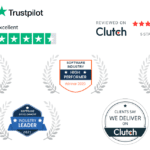Most start-ups believe that to grow, they absolutely need a full-time, in-house Chief Technology Officer (CTO).
Yet, this rigid perspective can sometimes overlook the financial and flexibility advantages of an on-demand solution.
Having spent years providing CTO-as-a-Service to various startups, I’ve seen how this model can expedite growth without sacrificing control or quality.
Companies need strong technology leadership to stay competitive. However, not every business can afford a full-time Chief Technology Officer (CTO). This is where CTO-as-a-Service (CaaS) comes in. It’s a flexible solution that allows companies to access top-level tech expertise without the cost and commitment of hiring a full-time executive.
What is CTO-as-a-Service?
CTO-as-a-Service is like having a part-time CTO. Instead of hiring a full-time executive, you can bring in an experienced tech leader on a temporary basis to help guide your company’s technology strategy, oversee projects, and mentor your team. This can be on a project basis, part-time, or as needed.
Imagine you’re a small startup with big ideas but limited resources. You need someone with a deep understanding of technology to help you navigate the complex landscape, but hiring a full-time CTO is beyond your budget. CTO-as-a-Service offers a perfect solution by providing the expertise you need, exactly when you need it, and without the long-term commitment.
Why Consider CTO-as-a-Service?

Here are some key reasons why more companies are turning to CaaS:
- Cost-Effective: Hiring a full-time CTO can be expensive, especially for startups and small businesses. CaaS allows you to get the expertise you need without the high salary and benefits costs.
- Flexibility: Your need for tech leadership can change over time. CaaS gives you the flexibility to scale up or down based on your current needs.
- Access to Top Talent: Finding the right CTO with the specific skills you need can be tough. CaaS connects you with experienced tech leaders who bring a wealth of knowledge and expertise.
- Focus on Core Business: By outsourcing your tech leadership, you can focus more on your core business activities, knowing that your technology strategy is in good hands.
Example: A fintech startup might need a CTO with deep expertise in financial regulations and blockchain technology. With CTO-as-a-Service, they can bring in an expert to navigate these specific challenges, without committing to a full-time salary and benefits.
Benefits of CTO-as-a-Service

Strategic Direction: A part-time CTO can help you develop and implement a clear technology roadmap that aligns with your business goals. They can provide strategic insights that ensure your tech initiatives are driving the company forward, not just keeping the lights on.
Innovation: Experienced CTOs bring fresh ideas and can help you leverage new technologies to stay ahead of the competition. They can identify and implement cutting-edge solutions that might not be on your radar, giving your business a competitive edge.
Risk Management: Technology projects come with inherent risks. A seasoned CTO can identify potential pitfalls early and develop mitigation strategies to ensure smooth project execution. This proactive approach can save your company from costly mistakes and delays.
Team Development: Beyond strategy and execution, CTOs play a crucial role in team development. They mentor and upskill your in-house teams, fostering a culture of continuous learning and improvement. This not only improves your team’s capabilities but also boosts morale and retention.
Adaptability: The needs of a business can change rapidly. A part-time CTO can adapt to these changes without the need for a lengthy hiring process. This means you can quickly pivot your strategy in response to new opportunities or challenges.
Objective Perspective: An external CTO brings an unbiased viewpoint to your company. They can provide objective assessments and recommendations, free from internal politics and biases, which can sometimes cloud decision-making processes.
Example: A healthcare company needed to implement a robust data security framework to comply with new regulations. By engaging a CTO-as-a-Service with specific expertise in healthcare data compliance, they successfully overhauled their security systems, ensuring compliance and protecting patient data.
How to Implement CTO-as-a-Service

- Define Your Needs: Clearly outline what you need from a CTO. This could be developing a tech strategy, overseeing a major project, or mentoring your team. Having specific goals will help you find the right fit and measure the success of the engagement.
- Choose the Right CTO: Look for a CaaS provider or individual with the right experience and a good track record. They should understand your industry and be able to work well with your team. Conduct thorough interviews and check references to ensure they have the necessary skills and cultural fit.
- Integrate Them Into Your Team: Treat the part-time CTO as a key member of your team. Regular communication and integration into your processes are crucial. Make sure they have access to all the information and resources they need to be effective. Encourage them to participate in key meetings and decision-making processes.
- Evaluate Regularly: Regularly assess the impact of CaaS on your business. Ensure they are meeting your needs and delivering value. Set up regular check-ins to review progress and adjust the engagement as necessary. Be open to feedback and willing to make changes to optimize the arrangement.
Example: An e-commerce company facing scalability issues defined their needs for a CTO who could design and implement a scalable infrastructure. They chose a CTO-as-a-Service with experience in large-scale systems, integrated them into the team through regular stand-ups and planning meetings, and evaluated their progress monthly. This approach helped the company scale efficiently without the long-term commitment of a full-time hire.
Examples of CTO-as-a-Service
Startup Expansion
A fast-growing SaaS startup needed to expand its product offering quickly to meet market demand. They brought in a part-time CTO who had a proven track record of scaling tech teams and launching new products. This CTO helped them build a robust architecture, recruit top engineering talent, and launch two new products within six months. The flexibility of the CaaS model allowed the startup to get the high-level expertise they needed without a long-term commitment.
Crisis Management
An established retail company faced a major data breach that threatened customer trust and business continuity. They hired a CTO-as-a-Service with extensive experience in cybersecurity. This interim CTO swiftly assessed the situation, implemented security protocols, and trained the internal team on best practices. Within weeks, the company had strengthened its defenses and restored customer confidence, all while avoiding the long lead times and costs associated with hiring a full-time executive.
Technological Transformation
A traditional manufacturing firm wanted to modernize its operations by implementing IoT solutions. They engaged a part-time CTO who specialized in IoT and digital transformation. The CTO developed a comprehensive strategy that included selecting the right technologies, integrating IoT into existing systems, and training staff. This transformation led to improved operational efficiency and significant cost savings.
Choosing the Right CTO-as-a-Service Provider

Selecting the right CTO-as-a-Service provider is crucial to ensure that your business gets the maximum benefit from this flexible leadership model. Here’s a step-by-step guide to help you make the best choice:
Understand Your Needs
Before you start searching for a provider, clearly define what you need from a CTO. Are you looking for someone to:
- Develop and execute a technology strategy?
- Oversee the implementation of major projects?
- Guide your team through a specific challenge like scaling infrastructure or enhancing security?
- Provide mentorship and development for your technical team?
Having a clear understanding of your needs will help you identify the right skills and experience required for your situation.
Look for Relevant Experience
The ideal CTO-as-a-Service provider should have a proven track record in your industry or in dealing with the specific challenges your business faces. Here are a few key aspects to consider:
- Industry Expertise: Look for a CTO with experience in your industry. They should understand the unique challenges and opportunities it presents.
- Technical Skills: Ensure the provider has the technical skills that match your needs, whether it’s cloud computing, cybersecurity, IoT, AI, or any other specialized area.
- Strategic Vision: A good CTO should not only have technical expertise but also be able to align technology initiatives with your overall business strategy.
Example: If you run a healthcare startup, a CTO with a background in health tech and regulatory compliance will be more valuable than someone with experience solely in e-commerce.
Assess Cultural Fit
Your CTO-as-a-Service provider will work closely with your existing team, so it’s important that they fit well with your company culture. Consider the following:
- Communication Style: Effective communication is key. The CTO should be able to articulate complex technical concepts in a way that is understandable to non-technical stakeholders.
- Leadership Style: They should have a leadership style that complements your team. Whether you need a hands-on leader or a strategic advisor, make sure their approach aligns with your expectations.
- Team Compatibility: The CTO should be able to integrate seamlessly with your team, fostering collaboration and trust.
Example: A company with a highly collaborative culture might look for a CTO who emphasizes team involvement and cross-departmental communication.
Evaluate Their Network
A well-connected CTO can bring additional value through their network. They might introduce you to potential partners, top-tier talent, or other resources that can benefit your business.
- Industry Contacts: A CTO with strong industry connections can provide insights and opportunities that are not readily available to others.
- Talent Network: They should have access to a pool of talented professionals who can be recruited to strengthen your team.
- Vendor Relationships: Established relationships with vendors can help in negotiating better deals and accessing cutting-edge technology.
Example: A CTO with a network of skilled software developers and engineers can help you quickly build a strong technical team.
Check References and Testimonials
Before making a final decision, check the provider’s references and testimonials. Reach out to their past clients to understand their experiences and the impact the CTO had on their business.
- Client Feedback: Positive feedback from previous clients is a strong indicator of the provider’s capability and reliability.
- Case Studies: Ask for case studies or examples of previous engagements that are similar to your needs. This can give you a clearer picture of what to expect.
- Reputation: A provider with a good reputation in the industry is likely to deliver high-quality services.
Example: A fintech company might seek testimonials from other financial services firms that have worked with the CTO, ensuring that the provider has successfully navigated similar challenges.
Ensure Flexibility and Scalability
Your needs may change over time, so it’s important to choose a provider who can adapt to these changes.
- Contract Terms: Look for flexible contract terms that allow you to scale the services up or down based on your requirements.
- Adaptability: The CTO should be able to pivot and adjust their approach as your business evolves.
- Long-Term Partnership: Consider whether the provider is interested in a long-term partnership, which can provide continuity and deeper strategic alignment.
Example: A startup that anticipates rapid growth might seek a CTO who has experience scaling businesses and can adjust their level of involvement as the company expands.
Choosing the Right CTO-as-a-Service Provider: Thinking outside the box
In the conventional wisdom of selecting a CTO-as-a-Service provider, businesses often focus on finding someone with a proven track record, industry-specific experience, and a strong cultural fit. While these are important considerations, taking a contrarian perspective can sometimes lead to even better outcomes. Here’s how thinking outside the box can help you choose the right CTO-as-a-Service provider.
Look Beyond Industry Experience
While it’s tempting to choose a CTO with deep roots in your specific industry, sometimes the best innovations come from cross-industry knowledge. A CTO with diverse experience across multiple sectors can bring fresh perspectives and novel solutions that someone entrenched in your field might overlook.
Example: A healthcare startup might benefit from a CTO with a background in e-commerce or gaming, as they can introduce user engagement techniques and cutting-edge technologies that are not yet common in the healthcare industry.
Prioritize Potential Over Proven Track Record
Instead of focusing solely on a CTO’s past achievements, consider their potential for future success. Look for qualities like adaptability, curiosity, and a willingness to challenge the status quo. These traits can be more valuable than a traditional resume filled with past successes.
Example: A rapidly growing tech company might choose a young, up-and-coming tech leader who has shown exceptional problem-solving skills and creativity, even if they lack extensive executive experience. This approach bets on their potential to grow with the company and drive innovative change.
Embrace the Outsider
Sometimes, an outsider who isn’t deeply embedded in the tech world can offer valuable insights. Someone with a background in a different discipline—like business strategy, psychology, or design—can provide unique perspectives that enrich your technology strategy.
Example: An established manufacturing firm looking to digitize its operations might hire a CTO with a background in organizational psychology. This outsider can help the company navigate the human aspects of digital transformation, ensuring that technology implementations are embraced by the workforce.
Seek the Challenger
A CTO who isn’t afraid to question your business model and challenge your assumptions can be incredibly valuable. This contrarian approach can uncover hidden inefficiencies and open up new avenues for growth.
Example: A retail company might benefit from a CTO who questions the necessity of a physical store presence and instead pushes for a more aggressive online strategy. This challenging perspective can drive the company to rethink its approach and potentially gain a competitive edge in the digital marketplace.
Value the Generalist Over the Specialist
While specialists have deep knowledge in one area, generalists can provide broader insights and connect the dots between different aspects of your business. A generalist CTO can help you see the bigger picture and integrate technology more holistically into your operations.
Example: A financial services firm might choose a CTO who has experience in various roles—such as product development, marketing, and operations—rather than someone who has spent their entire career in IT. This generalist approach ensures that technology decisions support overall business objectives.
Focus on Cultural Disruption
Instead of looking for a cultural fit, consider a CTO who can act as a cultural disruptor. Someone who brings a different viewpoint can help shake up complacent attitudes and inspire innovation.
Example: A traditional company stuck in outdated practices might hire a CTO from a fast-paced startup environment. This cultural disruptor can infuse the company with new energy, pushing it towards more agile and innovative ways of working.
Emphasize Soft Skills Over Hard Skills
Technical expertise is important, but soft skills like communication, empathy, and leadership are often what make a CTO truly effective. A CTO who excels in these areas can better manage teams, navigate conflicts, and drive change.
Example: A tech company undergoing rapid growth might prioritize hiring a CTO with exceptional people skills. This individual can help scale the team effectively, maintain morale, and ensure that everyone is aligned with the company’s vision.
Wrapping up
CTO-as-a-Service is more than just a cost-saving measure. It’s a strategic tool that helps companies innovate and grow. As technology continues to evolve, having flexible, top-level tech leadership will become increasingly important. CTO-as-a-Service offers a way to get the expertise you need, when you need it, without the overhead of a full-time executive.
Where technology drives business success, CTO-as-a-Service is a game-changer. It empowers businesses to stay agile, innovate continuously, and thrive in the digital age. Whether you’re a startup needing guidance or an established company facing new challenges, CTO-as-a-Service provides the strategic leadership necessary to navigate the complexities of today’s tech landscape.
By embracing this flexible model, businesses can ensure they remain at the forefront of innovation while optimizing their resources and focusing on their core strengths. CTO-as-a-Service is not just a trend but a transformative approach to technology leadership, poised to reshape how companies think about and implement their tech strategies.
Source Links
https://www.masterborn.com/blog/CTO-as-a-Service-What-is-CaaS-Key-benefits-and-risks
https://northell.design/blog/cto-as-a-service-ultimate-overview-pros-and-cons
https://clockwise.software/blog/cto-as-a-service-full-guide/














